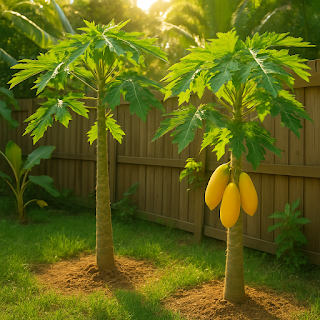Yellow Papaya – A Tropical Superfruit You Can Grow at Home
About Yellow Papaya
Yellow Papaya (Carica papaya) is a vibrant, fast-growing tropical fruit known for its bright yellow-orange flesh, refreshing sweetness, and incredible health benefits. This delicious fruit is packed with vitamin C, antioxidants, and digestive enzymes like papain, making it a must-have for health-conscious gardeners. Yellow papayas are slightly smaller and often sweeter than traditional red-fleshed varieties, making them perfect for fresh eating or juicing.
At SeedFella.com, we provide premium-quality Yellow Papaya seeds so you can grow this tropical delight in your own garden, greenhouse, or urban space.
Why Grow Yellow Papaya
There are many compelling reasons to grow Yellow Papaya:
-
Fast-growing fruit tree, bearing fruit within 6–12 months in warm conditions
-
Loaded with nutrients like vitamin C, A, potassium, and fiber
-
Helps improve digestion thanks to the natural enzyme papain
-
Beautiful in the landscape with its umbrella-like canopy and lush green foliage
-
Produces multiple harvests a year in tropical to subtropical climates
When to Plant Yellow Papaya Seeds
To ensure strong growth and fruit production:
-
Sow Yellow Papaya seeds in late spring to early summer
-
Soil temperatures should be above 21°C (70°F) for optimal germination
-
Start indoors or in a greenhouse if planting early or in cooler regions
-
Germination occurs in 1–3 weeks under warm, humid conditions
Where to Plant Yellow Papaya
Yellow Papaya trees thrive in:
-
Full sun, with at least 6–8 hours of direct sunlight daily
-
Well-drained, fertile soil enriched with organic compost
-
Areas protected from heavy winds and frost
-
Garden beds, containers, or greenhouse grow bags for controlled environments
How to Plant Yellow Papaya Seeds
-
Soak seeds in lukewarm water for 24–48 hours to improve germination
-
Sow seeds ½ inch deep in seed-starting mix or pots
-
Keep soil warm and moist; ideal temperature is 24–32°C (75–90°F)
-
Thin seedlings, keeping the strongest for transplanting
-
Transplant into well-prepared soil with ample drainage once 8–12 inches tall
How to Care for Yellow Papaya Plants
-
Water regularly, especially during dry spells—papayas need consistent moisture
-
Fertilize every 4–6 weeks with organic fruit fertilizer or compost tea
-
Prune lower leaves to promote air circulation and disease resistance
-
Protect from frost with cloth covers or greenhouse growing
-
Mulch around the base to retain soil moisture and suppress weeds
Companion Plants for Yellow Papaya
Yellow Papaya pairs well with:
-
Beans, basil, nasturtiums, and marigolds, which deter pests
-
Banana plants or lemongrass, which enjoy similar conditions
-
Avoid planting near aggressive root vegetables or deep-rooted trees
Harvesting Yellow Papaya
-
Fruits mature 5–9 months after flowering, depending on climate
-
Harvest when skin turns bright yellow and yields slightly to pressure
-
Use a clean knife to cut from the stem
-
Ripe papayas can be stored for up to a week at room temperature or chilled for longer
Uses of Yellow Papaya
-
Eaten fresh or added to smoothies, fruit salads, and desserts
-
Made into juices, jams, and sorbets
-
Used in marinades as a natural tenderizer (due to papain enzyme)
-
Leaves used traditionally in natural remedies and teas
-
A favorite in tropical cuisine and healthy eating recipes
Final Thoughts on Growing Yellow Papaya
Yellow Papaya is a rewarding fruit to grow for any organic gardener—easy to cultivate, fast to fruit, and incredibly nutritious. Its vibrant color, juicy sweetness, and lush tropical growth make it both practical and ornamental in your garden.
Order your Yellow Papaya seeds now from SeedFella.com and bring a taste of the tropics to your backyard.






Comments
Post a Comment